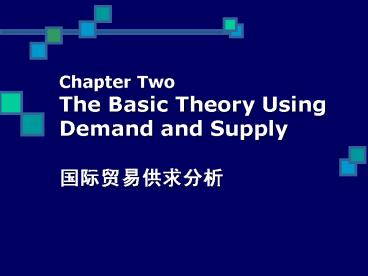Chapter Two The Basic Theory Using Demand and Supply ???????? - PowerPoint PPT Presentation
1 / 38
Title:
Chapter Two The Basic Theory Using Demand and Supply ????????
Description:
Chapter Two The Basic Theory Using Demand and Supply 2.1 Introduction Objective To analyze free trade equilibrium and gains from trade. – PowerPoint PPT presentation
Number of Views:115
Avg rating:3.0/5.0
Title: Chapter Two The Basic Theory Using Demand and Supply ????????
1
Chapter TwoThe Basic Theory Using Demand and
Supply????????
2
2.1 Introduction
- Objective
- To analyze free trade equilibrium and gains
from trade.
3
Contents
- Demand and supply curves
- Consumer and producer surplus
- No-trade (Autarky) equilibrium
- Free trade equilibrium
- Effects of free trade
4
2.2 Four Questions about Trade
- Why do countries trade? What determines the
pattern of trade ? - How does trade affect each countrys production
and consumption? - How does trade affect the economic well-being of
each country? - How does trade affect the distribution of income
among various groups within each country?
5
2.3 Demand and Supply
- Demand Curve
- The relationship between the price charged
and the quantity of a good demanded. - For a normal good, demand declines when price
rises.
6
(No Transcript)
7
2.3 Demand and Supply
- Price elasticity of demand
- Change in quantity demanded ()
- e-
- Change in price ()
- If egt 1, demand is elastic
- If elt 1, demand is inelastic.
8
2.3 Demand and Supply
- Consumer Surplus
- ?????
- Consumer well-being from the difference
between the value of a good and the price paid
for it.
9
At 2000/unit Total value (V) ctu Total
payment (P) tu Consumer surplus V - P c At
1000/unit ?
10
2.3 Demand and Supply
- Supply Curve
- The relationship between the price charged
and the quantity of a good supplied.
11
Upward sloping Increasing marginal cost ??????
12
2.3 Demand and Supply
- Price elasticity of supply
- Change in quantity supplied ()
- e
- Change in price ()
- If egt 1, supply is elastic
- If elt 1, supply is inelastic.
13
2.3 Demand and Supply
- Producer Surplus
- ?????
- Producer well-being from the difference
between the revenue received and the cost
incurred.
14
At 1000/unit Total Revenue (R) ez Total Cost
(C) z Producer surplus R - C e
At 2000/unit ?
15
2.4 No-trade Equilibrium
National supply National Demand
16
Consumer surplus c Producer surplus h ch ?
17
2.5 Free Trade Equilibrium
- A two-country world
- Home country USA
- Foreign country
- The rest of the world
18
No-trade Equilibrium A
19
No-trade equilibrium H
20
2.5 Free Trade Equilibrium
- Price Change and Trade
- Rest of the world Exporter
- Price
- Production Consumption
- Export Production - Consumption
21
(No Transcript)
22
2.5 Free Trade Equilibrium
- Price Change and Trade
- USA Importer
- Price
- Production Consumption
- Import Consumption - Production
23
(No Transcript)
24
- Free Trade Equilibrium
Foreign Exports US Imports
25
(No Transcript)
26
- Free Trade Equilibrium
- Foreign Exports
- US Imports
- 50 thousand units
- Price 1000/unit
27
(No Transcript)
28
- Free Trade Equilibrium
What if world price is above or below 1000/unit ?
29
Free Trade Equilibrium
800
Gap
30
2.6 Effects of Free Trade
- Effects in the importing country
- Effects on consumers
- Effects on producers
- Effects on the whole country
31
Producer surplus - a Consumer surplus (abd
) Net national gains bd
One dollar, one vote metric
32
2.6 Effects of Free Trade
- Effects in the exporting country
- Effects on consumers
- Effects on producers
- Effects on the whole country
33
Producer surplus (jkn) Consumer surplus -
(jk) Net national gains n
34
2.6 Effects of Free Trade
- Which country gains more?
- Both countries gain from free trade, but the
gains may be unequal.
35
Which country gains more?
36
Comparing (bd) and n
The side with less elastic trade curve gains
more.
n exporters surplus bd importers surplus
37
2.7 Summary
- A product will be exported from countries where
its price was lower without trade to countries
where its price was higher. - Trade affects production and consumption in both
countries. In the exporting country, production
rises while consumption falls. The opposite is
true for the importing country.
38
Summary
- Both countries gain from free trade. The country
with a less elastic trade curve or a larger price
change gains more. - Within the trading countries, gainers are
producers of exportable products and consumers of
imported products losers are producers of
import-competing products and consumers of
exportable products.































